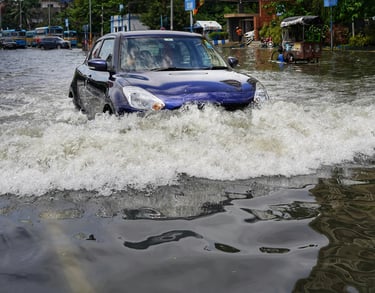What to Do After Your Car Gets Flooded?
Full Step-by-Step Process & Prevention Tips and Tricks
🚗 What to Do After Your Car Gets Flooded? Full Process & Prevention Tips
Car flooding is one of the worst nightmares for any vehicle owner. Whether it happens due to heavy rainfall, water-logging, or natural disasters, a flooded vehicle can cause major damage to the engine, electronics, and interior. Many people panic in such situations and end up making mistakes that cost them even more.
In this blog, we will explain in detail:
✅ Step-by-step process of what to do after your car gets flooded
✅ Common mistakes to avoid
✅ How to repair a flooded car
✅ Best tips to protect your vehicle from flood damage in the future
This guide is SEO-optimized, beginner-friendly, and practical, so that every reader can easily follow and save their car from further damage.
---
🌊 Immediate Steps to Take When Your Car Gets Flooded
1. Do Not Start the Car
The first instinct of most car owners is to turn the ignition on. ❌ This is the biggest mistake.
If water has entered the engine, starting the car can cause Hydrolock – a condition where water damages the piston and cylinder.
Wait until the car is fully inspected by a mechanic.
2. Disconnect the Battery
Water and electricity are a dangerous combination. If it is safe to access your car:
Disconnect the negative terminal of the battery.
This prevents short-circuits and protects the ECU (Electronic Control Unit).
3. Check Water Level Marks
Look at how high the water has risen:
If the water only touched the floor mats, the damage may be limited to interiors.
If water reached dashboard level or higher, engine and electronics might be heavily damaged.
4. Remove Water and Moisture Quickly
Use a vacuum or absorbent towels to remove standing water.
Keep car doors, windows, and boot open in sunlight for ventilation.
Use fans or dehumidifiers if available to prevent mold.
---
🔧 Professional Repair Process for Flooded Vehicles
Once your car is towed to a workshop, here’s the detailed process professionals usually follow:
1. Inspection & Assessment
Check if water entered the engine, transmission, or differential.
Inspect wiring, fuses, and sensors for short-circuits.
Take note of interior water damage (carpet, seats, dashboard).
2. Engine & Transmission Check
Drain engine oil, transmission oil, and coolant immediately.
Replace with fresh fluids.
Remove spark plugs and manually crank the engine to push out water.
In severe cases, engine disassembly and cleaning may be required.
3. Fuel System Cleaning
If water entered fuel tank, drain fuel completely.
Clean injectors and fuel lines.
4. Brake & Suspension Check
Water can rust brake discs and corrode suspension components.
Clean, lubricate, and replace damaged parts if required.
5. Electrical System Restoration
Dry and clean ECU, sensors, and wiring harness.
Replace damaged relays, fuses, and connectors.
Test all lights, horn, infotainment, and other electrical functions.
6. Interior Restoration
Remove and dry carpets, seats, and padding.
Clean with antibacterial solutions to prevent odor and mold.
In case of heavy damage, seats and carpet may need replacement.
---
❌ Common Mistakes Car Owners Make
1. Trying to Start the Car Immediately → Causes severe engine damage.
2. Ignoring the Smell of Dampness → Leads to mold growth.
3. Skipping Professional Inspection → Hidden damage in electronics can cause future breakdowns.
4. Delaying Insurance Claim → Flood damage claims must be reported immediately.
---
🛡️ How to Protect Your Car from Flood Damage
Prevention is always better than repair. Follow these tips:
Avoid Parking in Low-Lying Areas – Always choose higher ground in rainy season.
Install Rubber Floor Mats – Easier to clean after water exposure.
Use Car Covers Carefully – Avoid waterproof covers during heavy rains, they can trap moisture.
Regular Maintenance – Keep seals, rubber linings, and underbody coating in good condition.
Insurance Protection – Opt for comprehensive car insurance with natural calamity coverage.
---
📝 Conclusion
A flooded car can be stressful, but with the right steps and professional help, you can minimize the damage and even restore the vehicle completely.
🚫 Don’t start the engine immediately
🔧 Get fluids drained and systems inspected
🛡️ Follow preventive tips to avoid future flood damage
If your car has been affected by floods, don’t lose hope. With expert care and detailing services, your vehicle can be restored to a safe and reliable condition.
---
⭐ car kingdom provide solution
* What to do after car gets flooded
* Flooded car repair process
* How to fix a water damaged car
* Car restoration after flood
* Flood damage ca


Stay Updated on Repairs
Get the latest flood repair tips and news.